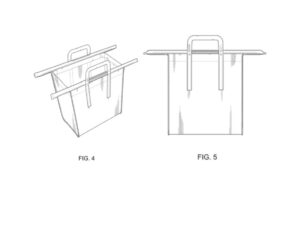In Golden Eye Media USA, Inc. v. EVO Lifestyle Products Ltd., the Federal Circuit affirmed summary judgment of invalidity of U.S. design patent D779,828 on the grounds that, inter alia, the design was functional. 2021-2096 (Fed. Cir. June 22, 2022)(“Golden Eye”).
Unlike utility patents, design patents are intended to protect the ornamental features of an article. “For a design to be protectable by a design patent, ‘the design must not be governed solely by function, i.e., that this is not the only possible form of the article that could perform its function.’” Id. citing Rosco, Inc. v. Mirror Lite Co., 304 F.3d 1373, 1378 (Fed. Cir. 2002). To evaluate whether a design is dictated by its function, the Federal Circuit has adopted a five factor test: (1) does the protected design represent the best design; (2) whether alternative designs would adversely affect the utility of the specified article, (3) are there any concomitant utility patents, (4) the advertising touts particular features having specific utility , and (5) are there any elements in the design or an overall appearance clearly not dictated by function. Sport Dimension, Inc. v. Coleman Co., 820 F. 3d 1316, 1322 (Fed. Cir. 2016). “The ‘availability of alternative designs [is] an important—if not dispositive—factor in evaluating the legal functionality of a claimed design.’” Golden Eye citing Endo-Surgery, Inc. v. Covidien, Inc., 796 F.3d 1312, 1329-30 (Fed. Cir. 2015).
With respect to functionality, the Federal Circuit reviews the district court’s findings for “clear error.” Given this deferential standard of appellate review, its important to win this argument in the district court. Thus, even though design patents enjoy a presumption of validity, it is critical for a patent owner fending off a validity challenge based on functionality to effectively demonstrate the availability of acceptable design alternatives.
The D828 patent is directed to a foldable bag. Figures 4 and 5, which show a perspective view and front view of the bag, are copied below. The bags are sold as reusable grocery bags and feature two horizontal rigid rods spanning the top opening which are intended to rest on the sides of a shopping cart and support the bag in un upright position while shopping.

Like all articles protected by design patents, this bag design has a utilitarian purpose. The question before the court, however, was not whether the article served a function but whether that function dictated the design. The district court performed the five part Sport Dimension inquiry and held that the design was functional. As noted in the Federal Circuit opinion “the patent owners TB UK discussed two alternative designs: (1) using two, larger bags to fill a shopping cart, and (2) a bag system in which the designer chooses not to fill the entire capacity of a shopping cart with the bags. The court properly disposed of those alternatives when it mentioned that “the only evidence of alternative designs [TB UK has] presented is that their bags could be smaller or bigger such that they would or would not fill the entire cart” and that these alternatives “directly impact[] the utility of the [’]828 [p]atent.” Golden Eye at 6. Based on this record, the Federal Circuit did not find “clear error” in the district court’s functionality holding. Based on this characterization of the evidence of alternative designs submitted by the patent owner to the district court, this seems to be a missed opportunity.
While the district court and Federal Circuit rulings may be correct based on the record that was created by the patent owner, is the D828 patent really an example of a design that is dictated by function?
The patented design is characterized by simple angular lines defining a rectangular face with a simple strap handle attached to the front face parallel to the sides. Even if the size and location of the two rods serve a function of supporting the bag in a shopping cart, how many possible alternatives to the overall bag design are there? After just a few minutes of brain storming, here are just a few possibilities:

Despite the child-like nature of my sketches, the point here is that by altering the shape of the bottom of the bag, the handle configuration, or the attachment of the bag to the rods, the overall appearance of the design changes meaningfully without impacting the bag’s function. Undoubtedly, a wide range of other design modifications are also possible. Of course, expert testimony would be needed to support each design and confirm that each proposed alternative was indeed substantially equivalent to the original design in terms of cost and utility, but given the nature of these design modifications, that does not seem to be an insurmountable challenge. At a minimum, evidence of an array of alternative designs should have been sufficient to create a question of fact that would have precluded summary judgment.
Design patents can be valuable intellectual property assets. When defending a design patent against a claim of invalidity based on functionality, establishing an evidentiary record of the availability of a range of alternative designs is critical to success. A bit of creativity can go a long way.
